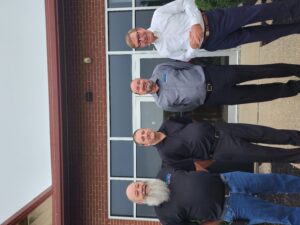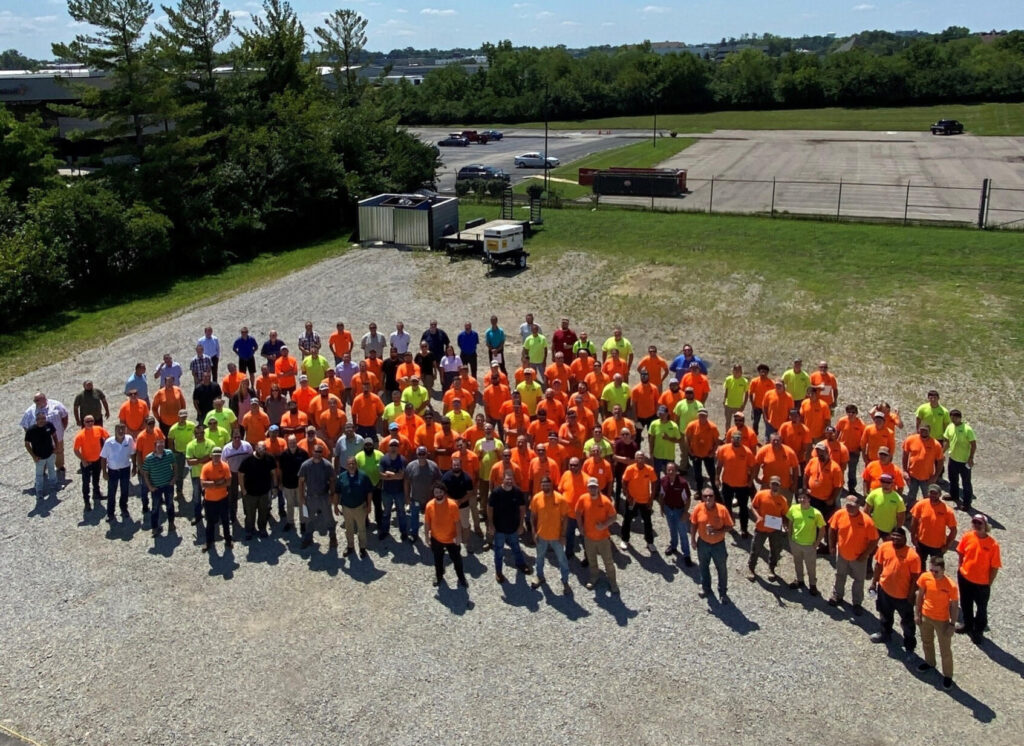Ohio Valley Electrical Services’ outgoing President Steve Ortner made the point abundantly clear as we sat for an interview to tell the story of the business he helped found. His belief in the team assembled there goes far beyond anecdotes and accolades. It has led to a new ownership model; an ESOP (Employee Stock Ownership Program) to be exact. The story begins almost 40 years ago, with a different company, and a full cast of characters.
It was 1983, and the U.S. economy was exiting a period of stagflation and pessimism. After graduation from Miami University, Steve moved to Pittsburgh to join the family business of selling railroad cars. It didn’t take long for Steve to miss his hometown of Cincinnati, so he began looking for work there. He landed a business development job with Garfield Electric, the largest open shop in the Cincinnati area. Steve built a rolodex full of contacts and helped Garfield land some significant contracts.
Fellow Garfield employee Scott Hughes’ path to the trade was more straightforward. “I was wiring houses when I was nine years old.” Scott’s first job was working for his grandfather’s electrical business. He accepted an electrical internship job between his junior and senior years of high school and decided to pursue a career in the trade after graduation. In 1990, Scott joined Garfield Electric as an apprentice.
Scott’s excellent work in the field eventually led to a management role at Garfield. As operations manager, he worked on bidding and specifying new projects. It was in this role that he first met Steve. “Steve’s no electrician, but he knows how to close deals.” Steve agrees with this sentiment. He’s a businessman, not a tradesman, who knows how to build relationships and find projects. Together, they made a great team, and Garfield Electric thrived. This growth didn’t go unnoticed.
Bigger Must Be Better
Unbeknownst to Steve and Scott, a new business entity was growing in Houston, Texas—one that would change their lives and their understanding of how businesses should be run. 
Richard K. Reiling was a waste management executive who saw an opportunity. There were plenty of small waste management companies around the country that could benefit from consolidation. With a group of colleagues, he formed an investment bank and began buying up waste management companies. When he ran out of those, he turned his attention to plumbing businesses, and later electrical contractors. He consolidated all of the brands under the name Encompass.
In 1998, Encompass purchased Garfield Electric, “along with our entire peer group,” Steve explained. Suddenly, Garfield was part of a multi-billion dollar public enterprise, with a management team based on Wall Street.
Steve understood the value proposition. “We could go to a building owner and offer to change a lightbulb, fix the HVAC, and mop the floors.” But the acquisitions required capital, and Encompass used leverage. That was a fine principle throughout the 1990’s economic expansion, but then came 9/11 and the 2001 recession. Encompass ran out of cash.
Both Steve and Scott saw the writing on the wall. Encompass was concerned about the bottom line, not taking care of client relationships. Together, they came up with a plan to purchase Garfield Electric’s Cincinnati and Columbus offices from Encompass. The client relationships were solid, and they knew the quality of the staff would be hard to replicate. This seemed like a winning proposal for both sides. Steve, Scott, and their colleagues could maintain the business they helped develop, and Encompass would get some badly needed cash.
Encompass dismissed the offer out of hand. Steve called a meeting in the office and said, “I’m leaving.” Steve had never signed a non-compete agreement when Encompass acquired Garfield—a detail the Encompass management team didn’t realize. So he left with Scott, Mike Nienhaus, Brent Foster, and Ron Kelley to start a competing business. Now all they needed were some sales.
Employees Become Employers
While at Garfield, Steve had been working on a large contract for DHL’s Cincinnati airport hub. He called his contact there and invited him for a round of golf to explain that he was starting his own firm. “You can guarantee me you won’t fall down?” Steve reassured his contact that their new company was ready for the business. “I’ll send you the bid,” Steve’s client replied.
Later that evening, in their newly rented warehouse, the four new business partners worked on the final details of the DHL bid. They watched as the fax machine came to life and dropped a signed contract onto the floor. Ohio Valley Electrical Services was officially in business. “I’m not going to lie, there were some adult beverages shared that night, and we all slept a bit easier,” Scott explained. All they needed now were some great employees. Fortunately, they knew some people looking for work.
In November 2003, Encompass filed for bankruptcy. By this time, Steve had successfully transitioned much of his Garfield Electric account business and developed new relationships as well. As Ohio Valley Electrical Services grew, the partners were able to hire many of their former Garfield co-workers. “Today, 75 percent of our project managers and field workers come from our Garfield days,” according to Steve.
The business plan for Ohio Valley Electrical Services was straightforward. While moving his work from Encompass to the new firm, Steve confirmed that relationships were more valuable than business names. Ohio Valley Electrical Services has always focused on selling: building relationships over searching for bids. They also developed some specialties, like working on conveyor systems for DHL at the airport. They thrived on complicated work that eliminated much of the competition.
Great workmanship and strong relationships fueled a growth trajectory. Except for a brief regression after the 2008 financial crisis, the company’s expansion has been steady. The workforce swelled to over 150 employees. “We never imagined this kind of success,” Scott explained. It became a big responsibility for the partners to plan for the future.
How Does this End?
In 2018, Mike retired, and Steve realized he too was ready to consider life after Ohio Valley Electrical Services. Scott, being the youngest original partner, would move from the COO to the CEO role. But the remaining partners began to wonder how the company could cover the buyout costs of the stock value the founders had amassed.
The partners hired a firm to help them through the transition. They began by looking into a private equity sale. After a few meetings, however, they realized this was too much like what they left behind at Encompass—non-electricians giving advice on how to run the business. They also investigated buyout opportunities from competitive electrical contractors, but their growth and valuation limited the number of firms that could buy the business outright. Their final idea was the most complicated of them all. They could let the employees buy the company through an ESOP.
There is no word in business more feared by some, loved by others, and misunderstood by most than ESOP. The idea of structuring a leveraged buyout for employees began in 1956 with a California newspaper. Louis O. Keso, a San Francisco lawyer, was hired to help Peninsula Newspaper’s two founders cash out at retirement. Prior to Keso’s idea, founders had limited options. They could sell to a competitor, where the brand and staff would be absorbed into the purchasing entity. Or they could sell the business to a few key employees—burdening them with massive debt obligations. Keso saw another path.
 What if the benefit of ownership could be shared by the entire company? This was Keso’s big idea. Now, we could fill a year’s worth of Insights pages with the rules and processes required for starting an ESOP, but in principle, the idea is quite simple. A company forms a trust that owns the business under the supervision of an outside trustee. They create a shareholder agreement that outlines the rules for share vesting and redemption. Finally, they hire an independent firm to value the business to annually determine the share price. Sound similar to a qualified retirement plan? It is, and thanks to Keso’s lobbying, an ESOP is comparatively tax efficient.
What if the benefit of ownership could be shared by the entire company? This was Keso’s big idea. Now, we could fill a year’s worth of Insights pages with the rules and processes required for starting an ESOP, but in principle, the idea is quite simple. A company forms a trust that owns the business under the supervision of an outside trustee. They create a shareholder agreement that outlines the rules for share vesting and redemption. Finally, they hire an independent firm to value the business to annually determine the share price. Sound similar to a qualified retirement plan? It is, and thanks to Keso’s lobbying, an ESOP is comparatively tax efficient.
The partners always thought of the company and their employees as family, and the employees always acted like owners of the business. It didn’t take long for them to agree that official employee ownership was the only good option. They hired a consulting firm to set up the ESOP trust. After the U.S. Department of Labor approved the agreement, all employees with three years of service were issued shares. And because the business is essentially a qualified retirement plan, Ohio Valley Electrical Services no longer pays state or federal income tax.
“It has taken some time for the idea of ownership to sink in,” Steve explained during our interview. Like a 401(k), the value becomes real over time as the asset grows. This past month, Ohio Valley Electrical Services employees gathered for the end-of-year, all company meeting where they review the financials and learn the new valuation. “The share price grew dramatically this year,” Scott explained. “You could see the reaction on the employees’ faces.” Ownership was becoming real.
Scott has a lot on his plate these days. Beyond taking over the CEO role, and the added responsibilities of maintaining client and vendor relationships, he also needs to think about developing his own replacement. He has another decade to figure this out, but as Scott explains, finding the next generation of talent hasn’t been easy. “We send 35-40 apprentices through IEC every year. Less than 20 percent graduate—I wish we had a cloning machine.”
Recruiting and retaining talent is the top business challenge at Ohio Valley Electrical Services.
“We have the work,” Scott says, “and we’re strong supporters of IEC for developing the workforce.” And in this case, a workforce of business owners.
To learn more about the ESOP process, go to www.nceo.org.
Ohio Valley Electric is a contractor member of IEC of Greater Cincinnati. In 2020, Ohio Valley Electric won IEC Excellence in Commercial Construction, Category C.
What is an ESOP?
An Employee Stock Ownership Plan (ESOP) is a regulated employee benefit plan that transfers company ownership to its employees over a period of time.
How does an ESOP work?
- A company sets up an ESOP trust through an independent financial institution. The company releases a finite number of shares to the trust.
- Company shares are valued by a third party.
- The company, its owners, and its employees transact within the trust.
- Over time, employees earn more shares of company stock (vesting) which are cashed out upon leaving the company.
- When a company buys stock back from an employee leaving the firm, it redistributes or voids the shares.
What are the advantages?
- ESOPs give companies a succession plan to prevent an owner(s) from being forced to sell the company to a new entity. As long as new employees come to the company, there will be a new suite of owners to hold stock as others retire.
- When a company experiences growth, the value of the stock increases, resulting in a higher cash-out for stock-holding employees. This incentive encourages employees to contribute to company growth.
- By earning more stock over time, ESOPs promote employee retention.


